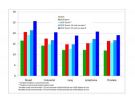(Press-News.org) Morgantown, WV, January 11, 2011 – A Blanchette Rockefeller Neurosciences Institute (BRNI) study published today in the Journal of Neuroscience reveals underlying causes for the degeneration of synapses in Alzheimer's Disease and identifies promising pharmaceutical solutions for the devastating condition that affects more than 5 million people in the United States. The BRNI study is the first to achieve fundamental molecular understanding of how synapses are lost in Alzheimer's Disease before the plaques and tangles develop. At the same time, it is the first study to demonstrate the comprehensive benefits of synaptogenic compounds in treating Alzheimer's Disease.
The BRNI study marks an important shift in our understanding of how Alzheimer's Disease is caused and should be treated. Previous autopsy-based studies have shown the critical role of synaptic loss in producing dementia (though, not the reason behind the degeneration), yet for decades scientists and pharmaceutical companies have focused on ways to target the amyloid plaques and neurofibrillary tangles thought to play a role in causing Alzheimer's Disease. By preventing the loss of synapses, BRNI's new therapeutics prevent the progressive symptoms of Alzheimer's Disease.
"Alzheimer's Disease is not primarily a disease of plaques and tangles as many had previously concluded, it is most importantly a disease of synapses," said Dr. Daniel Alkon, the scientific director of BRNI and co-author of the study, "This study found that treatments that target the loss of synapses in the Alzheimer's brain, can virtually eliminate all other elements of the disease – elevation of the toxic protein, A Beta, the loss of neurons, the appearance of plaques, and loss of cognitive function; the animals' brains were normalized."
The study utilized mice genetically engineered to express the symptoms and pathology of human Alzheimer's Disease in two different strains. BRNI used a difficult training regimen for the mice in order to reveal that significant cognitive deficits occurred five months before plaques were detected in their brains, providing evidence that plaques and tangles are not at the root of the disease.
Treatments of Bryostatin and similar compounds synthesized at BRNI that target the enzyme PKCε, which controls the creation of synapses at the molecular level, were administered for twelve weeks during the study. While the compounds promoted the growth of new synapses and preservation of existing synapses, they also stopped the decrease of PKCε and the increase of soluble β amyloid, meaning that the treatments could be used to prevent the familiar hallmarks of Alzheimer's Disease, the plaques and tangles. BRNI has received approval to move forward with Phase II clinical testing for Bryostatin to treat Alzheimer's Disease, which is set to begin within the next several months.
The synaptogenic BRNI drugs have also shown potential for the treatment of traumatic brain injury (TBI), as recently reported in the journal Neurobiology of Disease, and stroke described in the Proceedings of the National Academy of Science in 2008 and 2009.
The target of the synaptogenic compounds is the same molecule identified as a biomarker for early diagnosis of Alzheimer's Disease in clinical trials conducted by BRNI and published in Neurobiology of Aging in 2010. As a result of that study, researchers at the Institute are now working to develop a skin test for identifying Alzheimer's Disease in its early stages before significant progression.
INFORMATION:
This study is part of BRNI's ongoing commitment to bridging the gap between fundamental research in memory processes and the development of products and treatments for patients with Alzheimer's Disease and other memory impairments.
For more information on the Blanchette Rockefeller Neurosciences Institute please visit www.brni.org.
About Blanchette Rockefeller Neurosciences Institute:
Created in 1999, BRNI is the world's only non-profit institute dedicated to the study of both human memory and diseases of memory. Its primary mission is to accelerate neurological discoveries from the lab, including diagnostic tools and treatments, to the clinic where it can benefit patients who suffer from neurological and psychiatric diseases.
BRNI is operated in alliance with West Virginia University in Morgantown as well as in collaboration with other academic institutions such as Johns Hopkins University. West Virginia Senator Jay Rockefeller founded the Institute in memory of his mother, Blanchette Hooker Rockefeller, who died of Alzheimer's disease.
The estimated total cost of cancer care in the United States in 2020 is expected to be $158 billion assuming the most recent observed patterns of incidence, survival, and cost remain the same. This represents a 27% increase from 2010 due only to the projected aging and growth of the US population, according to a study published online January 12th in The Journal of the National Cancer Institute. However, the authors also note the cost of cancer care could rise even more quickly under some reasonable assumptions such as a 2% annual increase in costs of the initial and final ...
Washington, DC – Tinnitus appears to be produced by an unfortunate confluence of structural and functional changes in the brain, say neuroscientists at Georgetown University Medical Center (GUMC).
The phantom ringing sounds heard by about 40 million people in the U.S. today are caused by brains that try, but fail to protect their human hosts against overwhelming auditory stimuli, the researchers say in the January 13th issue of Neuron. They add that the same process may be responsible for chronic pain and other perceptual disorders.
The researchers say that the absence ...
Based on growth and aging of the U.S. population, medical expenditures for cancer in the year 2020 are projected to reach at least $158 billion (in 2010 dollars) – an increase of 27 percent over 2010, according to a National Institutes of Health analysis. If newly developed tools for cancer diagnosis, treatment, and follow-up continue to be more expensive, medical expenditures for cancer could reach as high as $207 billion, said the researchers from the National Cancer Institute (NCI), part of the NIH. The analysis appears online, Jan. 12, 2011, in the Journal of the National ...
(PHILADELPHIA) –The discovery that high levels of high-density lipoprotein (HDL) cholesterol (the "good cholesterol") is associated with reduced risk of cardiovascular disease has fostered intensive research to modify HDL levels for therapeutic gain. However, recent findings have called into question the notion that pharmacologic increases in HDL cholesterol levels are necessarily beneficial to patients. Now, a new study from researchers at the University of Pennsylvania School of Medicine shows that a different metric, a measure of HDL function called cholesterol efflux ...
A new study identifies a molecule that is a critical regulator of neuron survival after ischemic brain injury. The research, published by Cell Press in the January 13 issue of the journal Neuron, may lead to new therapies that reduce damage after a stroke or other injuries that involve an interruption in blood supply to the brain.
Ischemic brain injury is damage caused by a restriction in blood supply. Neuronal death after an interruption in the supply of oxygen and glucose involves a complex cascade of pathological events and, although previous research has identified ...
NIH-funded researchers were able to eliminate tinnitus in a group of rats by stimulating a nerve in the neck while simultaneously playing a variety of sound tones over an extended period of time, says a study published today in the advance online publication of the journal Nature. The hallmark of tinnitus is often a persistent ringing in the ears that is annoying for some, debilitating for others, and currently incurable. Similar to pressing a reset button in the brain, this new therapy was found to help retrain the part of the brain that interprets sound so that errant ...
SEATTLE – Astronomers who survey galaxies in the distant universe are getting some unexpected help from gravity, according to a new study.
In a presentation at the American Astronomical Society meeting this week and a related paper in the current issue of the journal Nature, researchers say that as many as 20 percent of the most distant galaxies currently detected appear brighter than they actually are, because of an effect called "strong gravitational lensing."
The discovery could change astronomers' notions of how galaxies formed in the early universe.
Haojing Yan, ...
Teeth and bone are important and complex structures in humans and other animals, but little is actually known about their chemical structure at the atomic scale. What exactly gives them their renowned toughness, hardness and strength? How do organisms control the synthesis of these advanced functional composites?
Now, using a highly sophisticated atomic-scale imaging tool on a sea creature's tooth, two Northwestern University researchers have peeled away some of the mystery of organic/inorganic interfaces that are at the heart of tooth and bone structure. They are the ...
New British-led research shows that starting treatment of blood pressure with two medicines rather than the one produces better and faster results and fewer side effects – findings that could change clinical practice world-wide.
The study, published in the Lancet, challenges popular medical practice for the treatment of high blood pressure. The research was led by Cambridge in collaboration with the Universities of Dundee, Glasgow and the British Hypertension Society.
Doctors usually start treatment with one medicine and then add others over a period of months, if needed, ...
Targeted nerve stimulation could yield a long-term reversal of tinnitus, a debilitating hearing impairment affecting at least 10 percent of senior citizens and up to 40 percent of military veterans, according to an article posted in the Jan. 12 online edition of Nature.
Researchers Dr. Michael Kilgard and Dr. Navzer Engineer from The University of Texas at Dallas and University-affiliated biotechnology firm MicroTransponder report that stimulation of the vagus nerve paired with sounds eliminated tinnitus in rats. A clinical trial in humans is due to begin in the next ...

